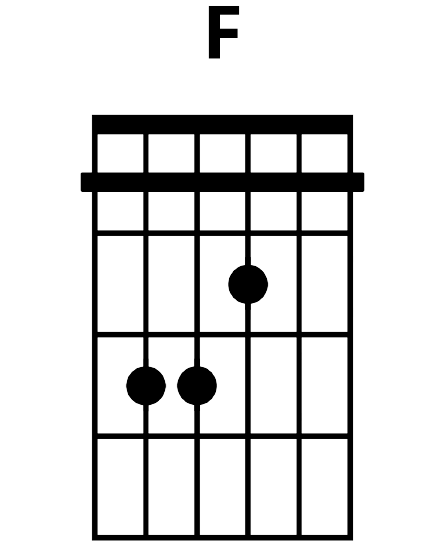

At this stage, you should be feeling a bit more comfortable playing the F major chord. Now it's time
to learn some more theory that will greatly improve the number of chords you're able to play. Look at
the E major and F major chords below. Do you notice a pattern? F major has the same chord shape as E
major does. The one major difference is the index finger is held flat against the first fret and the
middle, ring and pinky fingers are used to hold the chord shape. In contrast, you only need three
fingers to hold an E major chord. F major is the same shape as E major except shifted up a fret.


This logic can be applied again and again to play more chords. Make an E major shape with your middle, ring and pinky fingers. Hold your index finger down on the 5th fret. Now for the E major shape: place your middle finger on the 6th fret and your ring and pinky finger on the 7th fret. You are now playing an A major chord. See the list below for more details on how to play different bar chords with the E major shape. Note that the cycle repeats once you reach the 12th fret.
Why would I use a bar chord for something like A major rather
than the original A major chord from lesson 1? You're free to use either version of A major.
Sometimes you may prefer using the original A major chord because it reduces strain on the index finger.
You may, on the other hand, prefer to play A major as a bar chord if you're playing a number of bar chords
together. Playing a barred A major means you don't have to worry about holding and releasing your index
finger. It allows you to slide up and down the fretboard quicker.
What's with the hashtags after some chords listed above? A hashtag in
music is referred to as a sharp. Play an F major chord. Now play an F# major
chord. Do you hear that the F# major chord is slightly higher than the F major chord? This is because you're
playing something shifted up by a semitone.
Why is there no B# or E# listed above? Look at a piano if you have one at home.
If not, search for an image of a piano online. Look at the black keys relative to the white keys. Do you
notice that there are more white keys than black ones? The same pattern repeats as you glance up and down
the piano - two black keys, gap, three black keys, gap. Now look again: C# and D#; gap (no E#); F#, G# and
A#; gap (no B#). While C is a semitone above B and F is a semitone above E; it's rare to see these notes
written as B# or E#.
Now that we've learned about bar chords, try playing a few of our previously learned songs but with bar
chords instead. See the list of songs below.
Snow Patrol - Chasing Cars
The Beatles - Twist and Shout
Lynyrd Skynyrd - Sweet Home Alabama